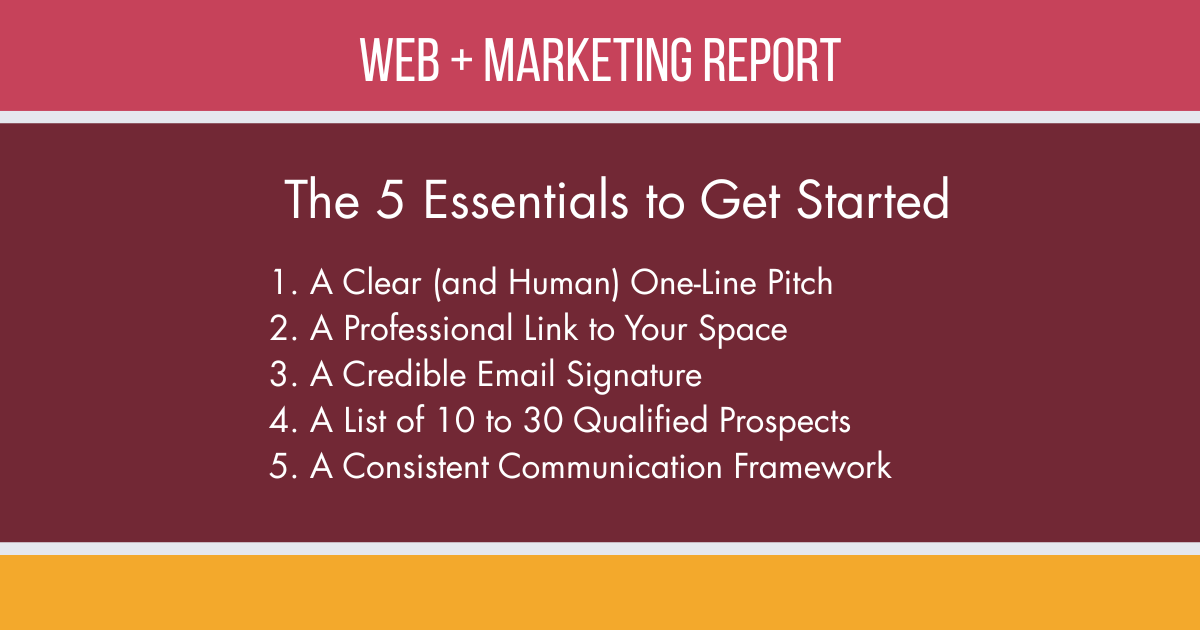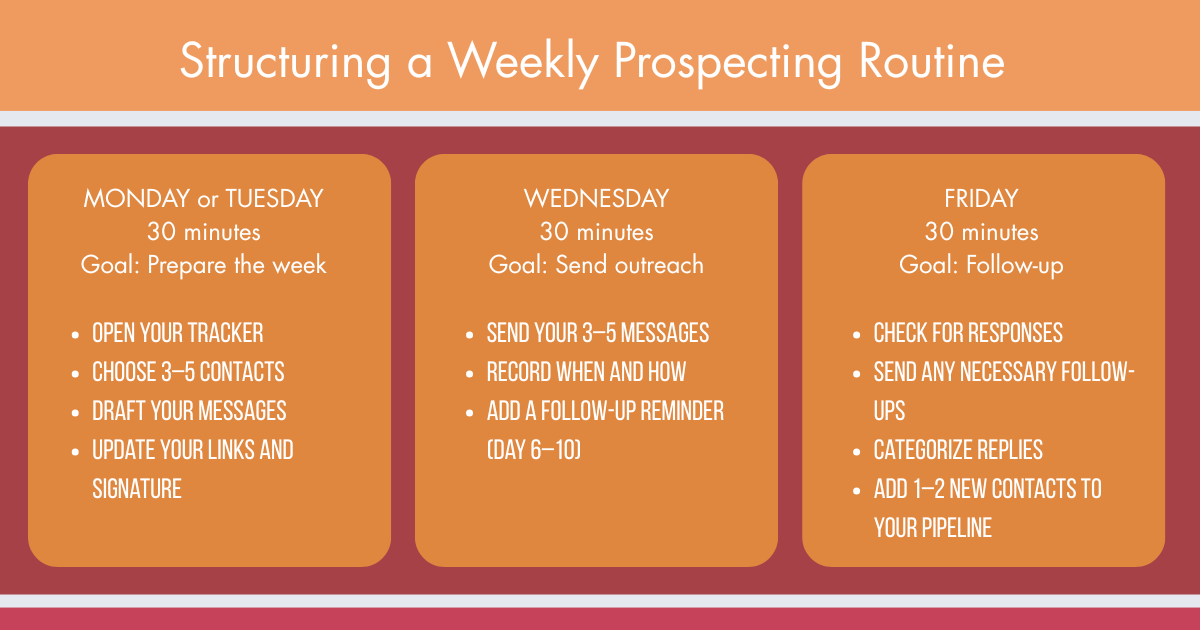Prospecting Without a Budget: Reach Out With Clarity and Confidence
Learn how to prospect without a budget: simple methods, structure, and real human connection — no tools, no gimmicks, just impact.
Hello,
Starting to prospect…
It’s often one of the tasks we put off. Not because we don’t understand its importance. But because we don’t always know where to begin or how to structure our first steps to get results.
As a new entrepreneur, freelancer, or creative professional, the idea of “prospecting” can feel paralyzing. We imagine a cold, repetitive, intrusive process. We think we need a team, a budget, fancy tools, a clean database, templates… and time.
But what if we shifted the perspective? What if, instead of waiting for a system to do it all, we began with a simple, human, and organized approach that evolves with us?
Since W+M was launched, one thing has become clear: Prospecting isn’t a fixed skill. It’s a living one, built day by day, project by project, contact by contact. This article was designed as a starting guide for anyone looking to break the silence and reach out with structure. Yes, we’ll talk strategy, but also tone, rhythm, consistency, and above all, authenticity.
MusicScore: This report was produced while listening to The Police Best of. Very effective! Here is Message in a Bottle - The Police. Isn’t the lyrics’ perfect for reading about prospecting? I hope that someone gets my Message in a bottle…
What is Prospecting Today?
Breaking the clichés and returning to the heart: the relationship
When people hear the word prospecting, the first images are rarely flattering: cold calls, impersonal mass emails, generic LinkedIn messages… or worse, persistent follow-ups that feel pushy.
Prospecting has a bad reputation mostly because it’s been poorly executed for years.
But at its core, prospecting is the art of initiating structured, intentional contact with people we’d truly like to serve.
It’s not about pushing a sale. It’s not about persuading with discounts. It’s not about shouting into the void and hoping someone bites. Instead, it’s about starting a useful, respectful conversation with someone we’ve carefully chosen—because they match what we offer.
Prospecting vs. Marketing
Marketing attracts. Prospecting initiates. They’re complementary.
Content marketing (articles, visuals, campaigns, ads) helps create presence and trust. Prospecting personalizes that presence: it goes straight to someone, intentionally.
Adjust, Then Adjust Again
Studies in B2B sales remind us: It’s not about the quality of your first message, it’s about your ability to follow up, adjust, and persist strategically.
Here are some key numbers:
It takes an average of 8 to 12 touchpoints to close a sale.
Only 2% of sales happen at the first contact.
Over 80% of prospects give up without sending a follow-up.
And 63% of people who ask never receive a reply.
The 5 Essentials to Get Started
You don’t need a website with a CRM, a big ad budget, or even a full business plan to start prospecting. Just these five core foundations. Here’s what you need before reaching out to anyone:
1. A Clear (and Human) One-Line Pitch
Be able to summarize your offer or value in one or two natural sentences, adaptable in writing or speech. This isn’t a slogan. It’s a simple positioning sentence, such as:
“I offer content creation services for small businesses looking to better structure their online presence.”
“I help artists and creators professionalize their communication and expand their network.”
This sentence follows you in every message, every bio, every intro.
2. A Professional Link to Your Showcase
This could be:
A product or service page (e.g., W+M Media Boutique)
A clean landing page (services, testimonials, images)
A professional Facebook or LinkedIn page
The most important thing is that people can click and instantly understand who you’re and what you offer. Use a link shortener like bit.ly or a custom domain (e.g., jeffmaheux.com/promo) for a clean look.
3. A Credible Email Signature
Your email = your digital business card.
You don’t need a flashy design, but it should include:
Full name
Role or profession
Link to your site or portfolio
Professional email (e.g., contact@web-plus-marketing.com)
Your logo or photo
You can use tools like WiseStamp, HubSpot Signature Generator, or Canva to create it.
4. A List of 10 to 30 Qualified Prospects
Not a cold bought list, but a manually built selection of people, companies, or the media you genuinely want to collaborate with.
Look for:
Shared values
Clear need for your offer
Activity in your niche or region
Track them in a simple table with: Name, contact, links, status (to contact, sent, followed up, responded).
5. A Consistent Communication Framework
No big social following yet? No problem. Just make sure what you do is aligned with what your message is about. If your service helps artists structure their image; your presence shouldn’t look disorganized.
Check these before sending messages:
A readable, polished profile picture
A website that’s up to date
A clear offer or value proposition
With these 5 essentials, you don’t need to wait for the “perfect version” of your brand or platform. Prospecting is like walking into a meeting room; better to arrive prepared than ever show up.
3 Simple Prospecting Techniques to Start With
Prospecting doesn’t start with automation. It starts with a thoughtful message, sent to the right person, with a clear intention: to build a first connection.
Personalized Email Outreach
Still one of the most effective methods.
How to:
Use your pro email
Address the right person
Start with a line showing genuine interest in their work
Introduce yourself in 1–2 simple lines
Share a relevant link
End with an invitation to connect
Example:
Hello [Name],
I came across your company via [source]. I was particularly drawn to [elements].
I’m [your name], and I work with businesses like yours to build strong, strategic content for a better online presence.
Here’s an example of what I offer: [link]
If it seems relevant, I’d be happy to explore further.
Best regards,
[Signature]
Even a 10–15% response rate is excellent if your outreach is targeted.
Direct Message via LinkedIn or Facebook (Short Version)
Private messages get read. Just don’t make them robotic or copy paste.
Tips:
Keep it short and personal
Don’t add links immediately
Ask or suggest a quick exchange
Be human, not “salesy”
Example:
Hi [Name],
I recently came across your project and found it truly inspiring. I work in a related field and wondered if you’d considered [collaboration, support, etc.].
If you’re open to a quick chat, I’d love to connect.
All the best,
Jeff
Send your message after engaging with one of their posts. It shows a genuine interest.
Soft Invitation via Content (Article, Guide, Promo)
Sometimes, instead of offering a service directly, you can invite someone to discover a useful piece of content:
A blog article
A section from your white paper
A product or service sheet
A page from your monthly publication
Do:
Send a simple message with a link and a note like:
“I thought this might interest you—it touches on a topic you recently shared.”
or
“I had you in mind when I published this. Curious to hear your thoughts if you have a moment.”
This creates a low-pressure entry point and showcases your value upfront.
Organizing Your Prospecting + Follow-Ups
You’ve sent a message. It’s been read. No reply… Now what?
This is where 80% of prospecting happens; not in the first message, but in how you follow up, organize, and persist.
Build a Simple Follow-Up Tracker
You don’t need a fancy tool, just a spreadsheet or Trello board that’s clean and consistent.
Example fields:
Name
Contact info
First message date
Status (waiting, replied, declined)
Last action taken
Follow-up due
Set 2 fixed times per week to send new messages and review your tracker (e.g., Tuesday morning and Friday afternoon).
Following Up With Respect
Most people don’t ignore you. They just forget. Here’s how to follow up without being pushy:
Email Follow-Up (Day 6 –10):
Hello [Name],
Just following up on my previous message. I understand you’re likely very busy. If you’d like to discuss further or have any questions, I’d be happy to connect.
Best regards,
Jeff
LinkedIn Follow-Up:
Hi [Name],
Just checking in, maybe my message slipped through. I’d be glad to chat if the topic still interests you. Have a great day!
Limit yourself to two follow-ups per platform. Beyond that, move on or revisit in a few months.
Create a Prospecting Ritual
One key to success: consistency. You don’t need 10 hours a week, just:
1–2 fixed blocks in your calendar
1 clear tracking system
1 way to measure progress (responses, opens, links clicked)
Even 3 contacts per week is enough to:
Refine your message
Understand your audience
Build a database
Generate future opportunities
Prospecting is like gardening. You won’t see growth overnight, but what you plant today could bear fruit in 3, 6, or 12 months.
Structuring a Weekly Prospecting Routine
One hour per week could transform your business.
Let’s keep it simple:
MON or TUE – 30 min
Goal: Prepare for the week
Open your tracker
Choose 3–5 contacts
Draft your messages
Update your links and signature
WED – 30 min
Goal: Send outreach
Send your 3–5 messages
Record when and how
Add a follow-up reminder (Day 6–10)
FRI – 30 min
Goal: Follow-up
Check for responses
Send any necessary follow-ups
Categorize replies
Add 1–2 new contacts to your pipeline
Energy vs. Time
We don’t always have the same energy level. Here’s how to adapt:
Low energy? Prep messages or clean your sheet
Creative burst? Tweak your pitch or web page
Tired up? Send more messages or go for a bold follow-up.
Always keep moving, even in small steps. With this simple structure, you’ll avoid:
Forgetting follow-ups
Late replies
Losing great contacts
Mental clutter
Conclusion
Prospecting may feel intimidating at first. But it becomes more natural and even motivating once you see it as a human, intentional, structured practice that serves your mission.
You don’t need a big budget. You don’t need a team. You need a clear pitch. A clean link. A real signature.
And the courage to hit “send.” One well-written message is worth more than ten unshared ideas. A polite follow-up is better than letting silence bury your work.
Prospecting isn’t a sprint. It’s a form of steady presence. And each gesture you make today lays the foundation for tomorrow’s opportunity.
Thank you for reading. See you on The Blog!
Jeff Maheux
Sources:
HubSpot – Sales Benchmarks Report 2024
Salesforce – State of Sales Reports
Invest – Sales Follow-Up Statistics
Marketing Donut – Customer Touchpoints
Close.com – Outbound Sales Playbook.
Cr images: Production Services W+M.
Websites - creation, management and design
I edit the content of existing sites via CMS in addition to creating sites with WordPress and Squarespace. I have been producing website content as a webmaster since 1998.
I help companies get their first website up and I improve the performance of existing sites.
Yes, I’m Mr. Analytics and my reaction time to new digital marketing is daily, which allows my clients to have optional and trend-cutting tools.
Follow the content of the marketing blog and participate in the articles by commenting, with respect, on the content of the site, intended for Quebec companies operating in the digital market.










Learn how to structure your presence on X with professional Highlights: choosing the right content, organizing your featured posts, and designing a clear visual identity.